Depth-Resolved Phase Analysis of Expanded Austenite Formed in Austenitic Stainless Steel
Abstract
:1. Introduction
2. Materials and Methods
3. Results
3.1. Peculiarities of (200) Reflection for the Expanded Phase
3.2. Depth-Dependent Investigations
4. Discussion
5. Summary and Conclusions
Author Contributions
Funding
Conflicts of Interest
References
- Washko, S.D.; Aggen, G. Wrought Stainless Steels. In ASM Handbook; ASM International: Materials Park, OH, USA, 1997; Volume 1, pp. 841–907. [Google Scholar]
- McGuire, M.F. Stainless Steels for Design Engineers; ASM International: Materials Park, OH, USA, 2008; ISBN 978-0-87170-717-8. [Google Scholar]
- Lerner, R.M. Glow-discharge nitriding of Nitralloy 135M and AISI304 stainless steel. J. Iron Steel Inst. 1972, 210, 631–632. [Google Scholar]
- Lebrun, J.-P.; Michel, H.; Gantois, M. Nitruration par bombardement ionique des aciers inoxydables 18-10. Mémoires Sci. La Rev. Métallurgie 1972, 69, 727–738. [Google Scholar]
- Somers, M.A.J.; Christiansen, T.L. Low temperature surface hardening of stainless steel. In Thermochemical Surface Engineering of Steels; Mittemeijer, E.J., Somers, M.A.J., Eds.; Woodhead Publishing: Oxford, UK, 2015; pp. 557–579. ISBN 978-0-85709-592-3. [Google Scholar] [CrossRef]
- Ichii, K.; Fujimura, K.; Takase, T. Microstructure, corrosion resistance, and hardness of the surface layer in ion nitrided 18-8 stainless steel. Netsu Shori 1985, 25, 191–195. [Google Scholar]
- Sun, Y.; Haruman, E. Low temperature plasma surface alloying of austenitic stainless steels. Solid State Phenom. 2006, 118, 85–90. [Google Scholar] [CrossRef]
- Zhang, Z.L.; Bell, T. Structure and corrosion resistance of plasma nitrided stainless steel. Surf. Eng. 1985, 1, 131–136. [Google Scholar] [CrossRef]
- Borgioli, F. From austenitic stainless steel to expanded austenite-s phase: Formation, characteristics and properties of an elusive metastable phase. Metals 2020, 10, 187. [Google Scholar] [CrossRef] [Green Version]
- Czerwiec, T.; He, H.; Marcos, G.; Thiriet, T.; Weber, S.; Michel, H. Fundamental and innovations in plasma assisted diffusion of nitrogen and carbon in austenitic stainless steels and related alloys. Plasma Process. Polym. 2009, 6, 401–409. [Google Scholar] [CrossRef]
- Fewell, M.P.; Priest, J.M. High-order diffractometry of expanded austenite using synchrotron radiation. Surf. Coat. Technol. 2008, 202, 1802–1815. [Google Scholar] [CrossRef]
- Mändl, S.; Rauschenbach, B. Anisotropic strain in nitrided austenitic stainless steel. J. Appl. Phys. 2000, 88, 3323–3329. [Google Scholar] [CrossRef]
- Velterop, L.; Delhez, R.; de Keijser, T.H.; Mittemeijer, E.J.; Reefman, D. X-ray diffraction analysis of stacking and twin faults in f.c.c. metals: A revision and allowance for texture and non-uniform fault probabilities. J. Appl. Crystallogr. 2000, 33, 296–306. [Google Scholar] [CrossRef]
- Brink, B.K.; Ståhl, K.; Christiansen, T.L.; Oddershede, J.; Winther, G.; Somers, M.A.J. On the elusive crystal structure of expanded austenite. Scr. Mater. 2017, 131, 59–62. [Google Scholar] [CrossRef] [Green Version]
- Christiansen, T.; Somers, M.A.J. Avoiding ghost stress on reconstruction of stress-and composition-depth profiles from destructive X-ray diffraction depth profiling. Mater. Sci. Eng. A 2006, 424, 181–189. [Google Scholar] [CrossRef]
- Sienz, S.; Mändl, S.; Rauschenbach, B. In-situ stress measurements during low energy nitriding of stainless steel. Surf. Coat. Technol. 2002, 156, 185–189. [Google Scholar] [CrossRef]
- Christiansen, T.L.; Hummelshøj, T.S.; Somers, M.A.J. Expanded austenite, crystallography and residual stress. Surf. Eng. 2010, 26, 242–247. [Google Scholar] [CrossRef]
- Lutz, J.; Manova, D.; Gerlach, J.W.; Störmer, M.; Mändl, S. Interpretation of glancing angle and bragg-brentano XRD Measurements for CoCr alloy and austenitic stainless steel after PIII nitriding. IEEE Trans. Plasma Sci. 2011, 39, 3056–3060. [Google Scholar] [CrossRef]
- Manova, D.; Mändl, S. Perspectives: In-situ XRD measurements to explore phase formation near surface region. J. Appl. Phys. 2019, 126, 200901. [Google Scholar] [CrossRef]
- Henke, B.L.; Gullikson, E.M.; Davis, J.C. X-ray interactions: Photoabsorption, scattering, transmission, and reflection at E = 50–30000 eV, Z = 1–92. Data Nucl. Data Tables 1993, 54, 181–342. [Google Scholar] [CrossRef] [Green Version]
- Manova, D.; Mändl, S.; Gerlach, J.W.; Hirsch, D.; Neumann, H.; Rauschenbach, B. In situ X-ray diffraction investigations during low energy ion nitriding of austenitic stainless steel grade 1.4571. J. Phys. D Appl. Phys. 2014, 47, 365301. [Google Scholar] [CrossRef]
- Mändl, S. Nitriding of stainless steel: PIII or low energy nitriding? Plasma Proc. Polym. 2007, 4, 239–245. [Google Scholar] [CrossRef]
- Neumann, H.; Tartz, M.; Scholze, F.; Chassé, T.; Kersten, H.; Leiter, H. Broad beam ion sources for electrostatic space propulsion and surface modification processes: From roots to present applications. Contrib. Plasma Phys. 2007, 47, 487–497. [Google Scholar] [CrossRef]
- Brink, B.; Ståhl, K.; Christiansen, T.L.; Somers, M.A.J. Thermal expansion and phase transformations of nitrogen-expanded austenite studied with in situ synchrotron X-ray diffraction. J. Appl. Crystallogr. 2014, 47, 819–826. [Google Scholar] [CrossRef]
- Dienelt, J.; Zimmer, K.; Scholze, F.; Dathe, B.; Neumann, H. Generation of a pulsed ion beam with a tuned electronic beam switch. Plasma Sources Sci. Technol. 2003, 12, 489–494. [Google Scholar] [CrossRef]
- Manova, D.; Lutz, J.; Mändl, S. Sputtering effects during plasma immersion ion implantation of metals. Surf. Coat. Technol. 2010, 204, 2875–2880. [Google Scholar] [CrossRef]
- Williamson, D.L.; Davis, J.A.; Wilbur, P.J. Effect of austenitic stainless steel composition on low-energy, high-flux, nitrogen ion beam processing. Surf. Coat. Technol. 1998, 103, 178–184. [Google Scholar] [CrossRef]
- Blawert, C.; Weisheit, A.; Mordike, B.L.; Knoop, F.M. Plasma immersion ion implantation of stainless steel: Austenitic stainless steel in comparison to austenitic-ferritic stainless steel. Surf. Coat. Technol. 1996, 85, 15–27. [Google Scholar] [CrossRef]
- Manova, D.; Günther, C.; Bergmann, A.; Mändl, S.; Neumann, H.; Rauschenbach, B. Influence of temperature on layer growth as measured by in-situ XRD observation of nitriding austenitic stainless steel. Nucl. Instrum. Methods B 2013, 307, 310–314. [Google Scholar] [CrossRef]
- Williamson, D.L.; Ozturk, O.; Wei, R.; Wilbur, P.J. Metastable phase formation and enhanced diffusion in f.c.c. alloys under high dose, high flux nitrogen implantation at high and low ion energies. Surf. Coat. Technol. 1994, 65, 15–27. [Google Scholar] [CrossRef]
- Manova, D.; Díaz, C.; Pichon, L.; Abrasonis, G.; Mändl, S. Comparability and accuracy of nitrogen depth profiling in nitrided austenitic stainless steel. Nucl. Instrum. Methods B 2015, 349, 106–113. [Google Scholar] [CrossRef]
- Blawert, C.; Mordike, B.L.; Collins, G.A.; Short, K.T.; Jirásková, Y.; Schneeweiss, O.; Perina, V. Characterisation of duplex layer structures produced by simultaneous implantation of nitrogen and carbon into austenitic stainless steel X5CrNi189. Surf. Coat. Technol. 2000, 128, 219–225. [Google Scholar] [CrossRef]
- Mändl, S.; Dunkel, R.; Hirsch, D.; Manova, D. Intermediate stages of CrN precipitation during PIII nitriding of stainless steel. Surf. Coat. Technol. 2014, 258, 722–726. [Google Scholar] [CrossRef]
- Manova, D.; Lotnyk, A.; Mändl, S.; Neumann, H.; Rauschenbach, B. CrN precipitation and elemental segregation during the decay of expanded austenite. Mater. Res. Express 2016, 3, 066502. [Google Scholar] [CrossRef]
- Martinavičius, A.; Abrasonis, G.; Möller, W.; Templier, C.; Rivière, J.P.; Declémy, A.; Chumlyakov, Y. Anisotropic ion-enhanced diffusion during ion nitriding of single crystalline austenitic stainless steel. J. Appl. Phys. 2009, 105, 93502. [Google Scholar] [CrossRef]
- Christiansen, T.; Somers, M. Controlled dissolution of colossal quantities of nitrogen in stainless steel. Met. Mater. Trans. 2006, 37A, 675–682. [Google Scholar] [CrossRef]
- Ledbetter, H.M.; Austin, M.W. Dilation of an fcc Fe–Cr–Ni alloy by interstitial carbon and nitrogen. Mater. Sci. Technol. 1987, 3, 101–104. [Google Scholar] [CrossRef]
- Manova, D.; Lutz, J.; Gerlach, J.W.; Neumann, H.; Mändl, S. Relation between lattice expansion and nitrogen content in expanded phase after nitrogen insertion in austenitic stainless steel and CoCr alloys. Surf. Coat. Technol. 2011, 205, S290–S293. [Google Scholar] [CrossRef]
- Wu, D.; Kahn, H.; Dalton, J.C.; Michal, G.M.; Ernst, F.; Heuer, A.H. Orientation dependence of nitrogen supersaturation in austenitic stainless steel during low-temperature gas-phase nitriding. Acta Mater. 2014, 79, 339–350. [Google Scholar] [CrossRef]
- Fonović, M.; Leineweber, A.; Robach, O.; Jägle, E.A.; Mittemeijer, E. The nature and origin of “double expanded austenite” in Ni-based Ni–Ti alloys developing upon low temperature gaseous nitriding. J. Met. Mater. Trans. 2015, 46, 4115–4131. [Google Scholar] [CrossRef]
- Jafarpour, S.M.; Puth, A.; Dalke, A.; Böcker, J.; Pipa, A.V.; Röpcke, J.; van Helden, J.-P.; Biermann, H. Solid carbon active screen plasma nitrocarburizing of AISI 316L stainless steel in cold wall reactor: Influence of plasma conditions. J. Mater. Res. Technol. 2020, 9, 9195–9205. [Google Scholar] [CrossRef]
- Manova, D.; Hirsch, D.; Gerlach, J.W.; Mändl, S.; Neumann, H.; Rauschenbach, B. In-situ Investigation of phase formation during low energy ion nitriding of Ni80Cr20 alloy. Surf. Coat. Technol. 2014, 259, 434–441. [Google Scholar] [CrossRef]
- Gai, Z.; Lin, W.; Burton, J.; Fuchigami, K.; Snijders, P.C.; Ward, T.Z.; Tsymbal, E.Y.; Shen, J.; Jesse, S.; Kalinin, S.V.; et al. Chemically induced Jahn–Teller ordering on manganite surfaces. Nat. Commun. 2014, 5, 4528. [Google Scholar] [CrossRef] [Green Version]
- Panigrahi, P.; Hussain, T.; Araujo, C.M.; Ahuja, R. Hole induced Jahn Teller distortion ensuing ferromagnetism in Mn-MgO: Bulk, surface and one dimensional structures. J. Phys. Condens Matter. 2014, 26, 265801. [Google Scholar] [CrossRef] [PubMed]
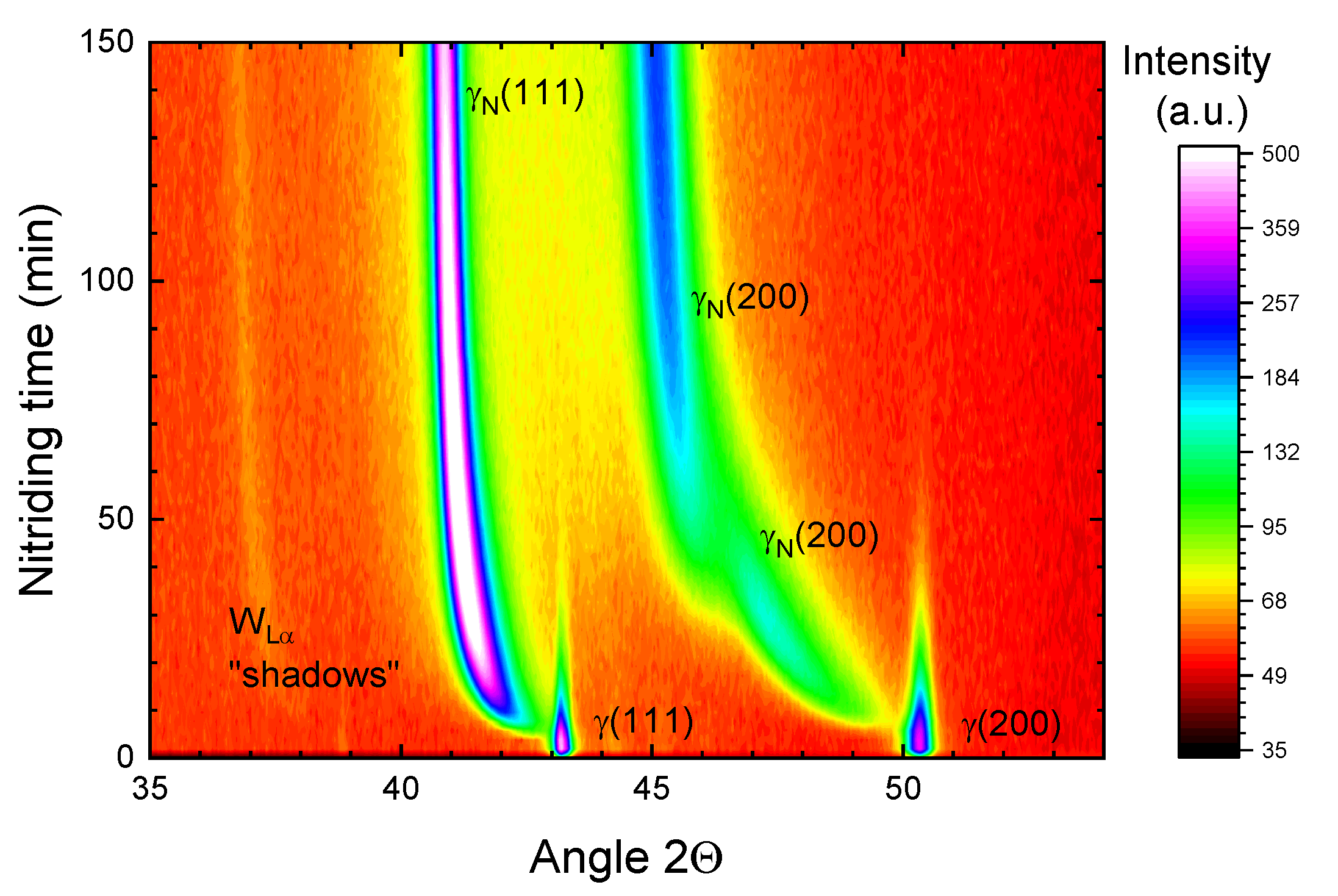
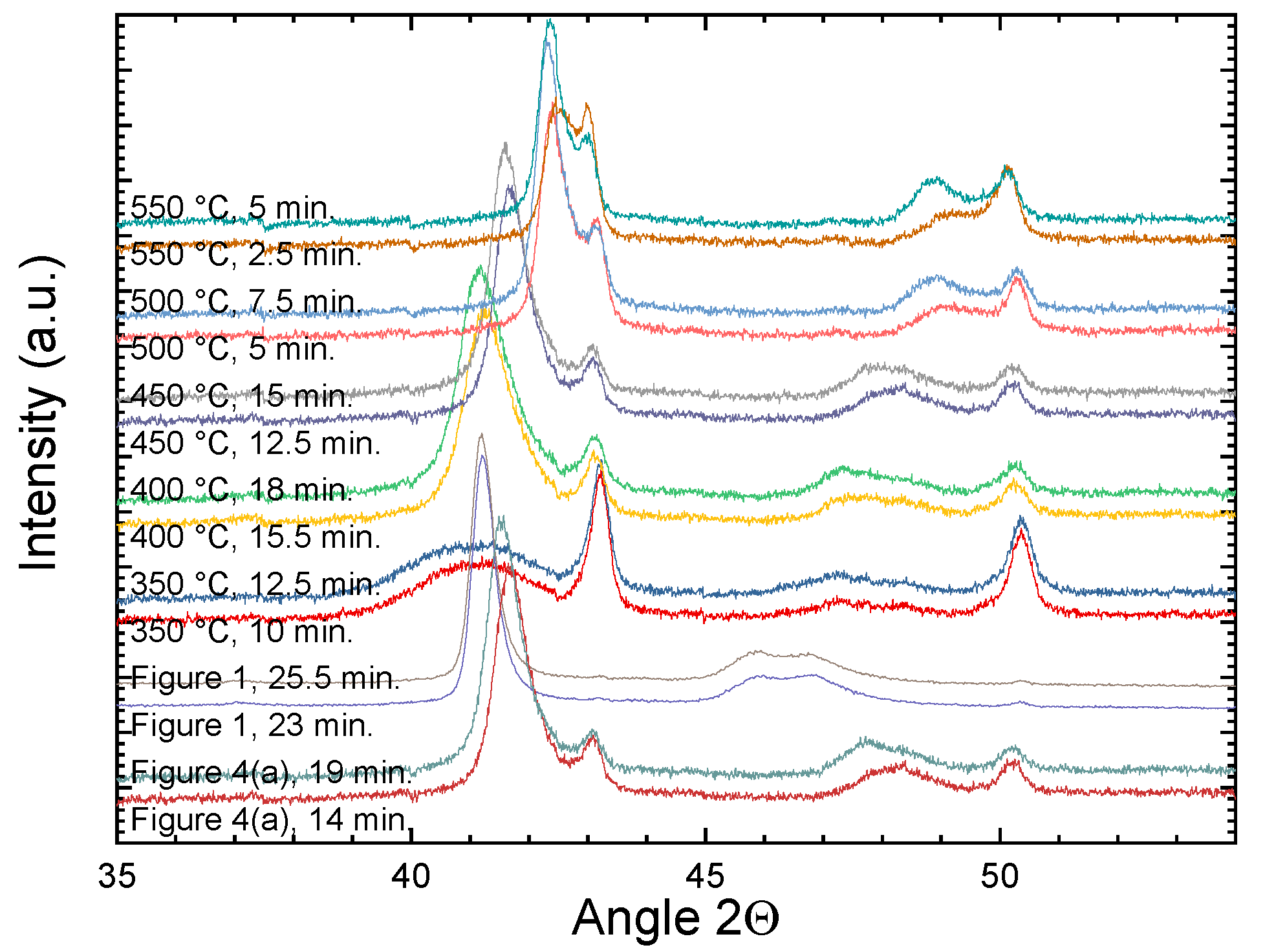
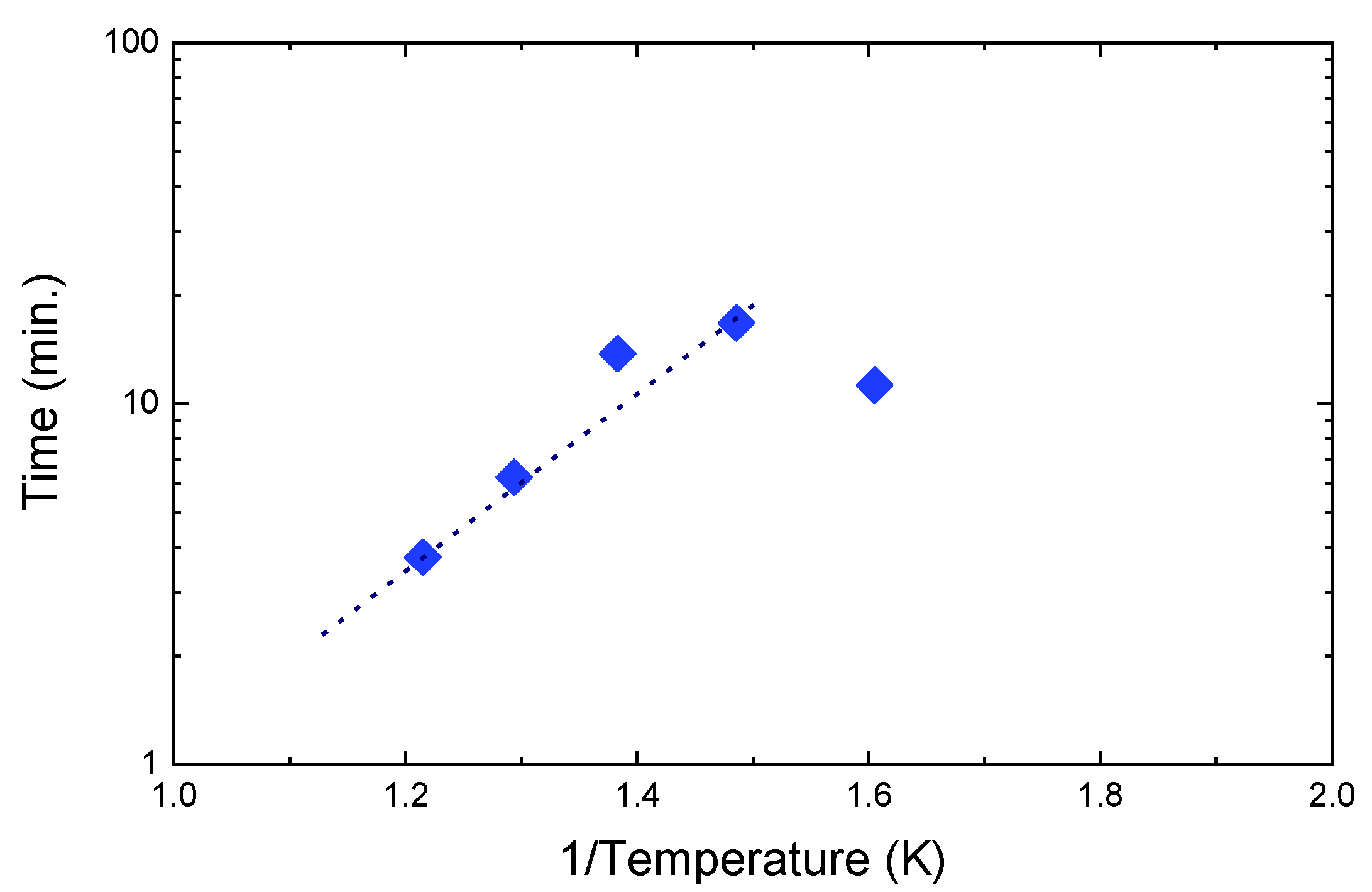
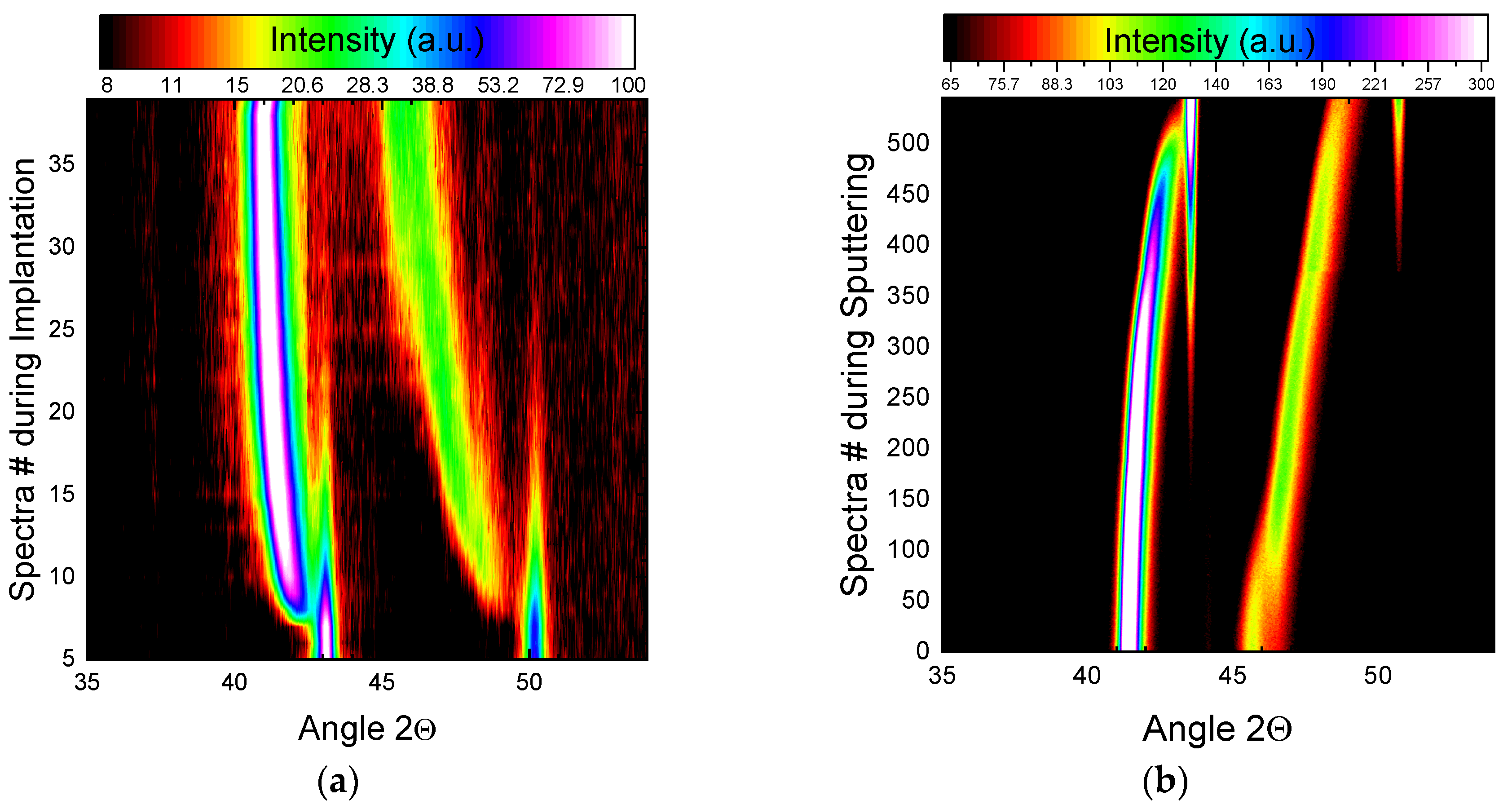
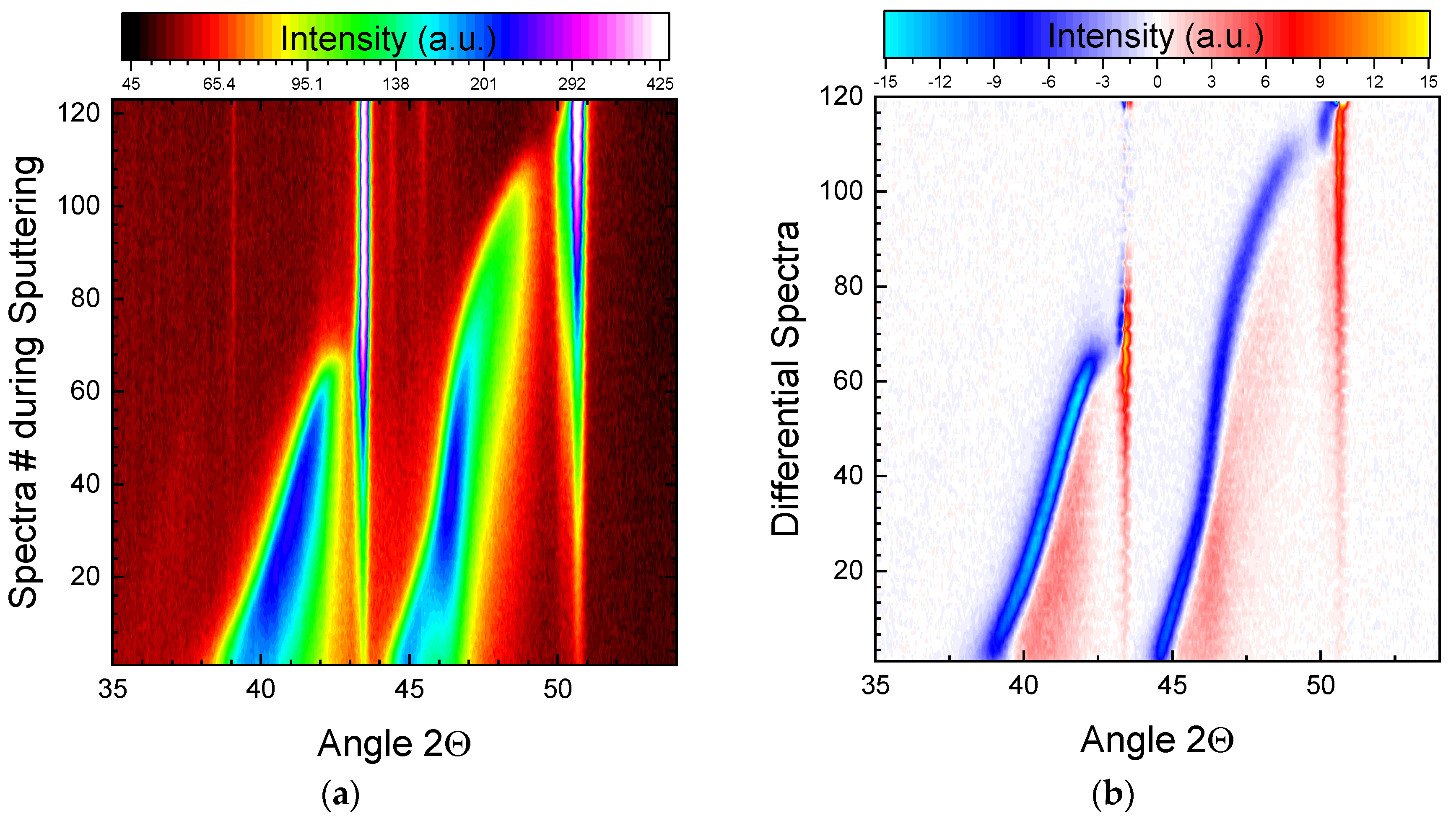



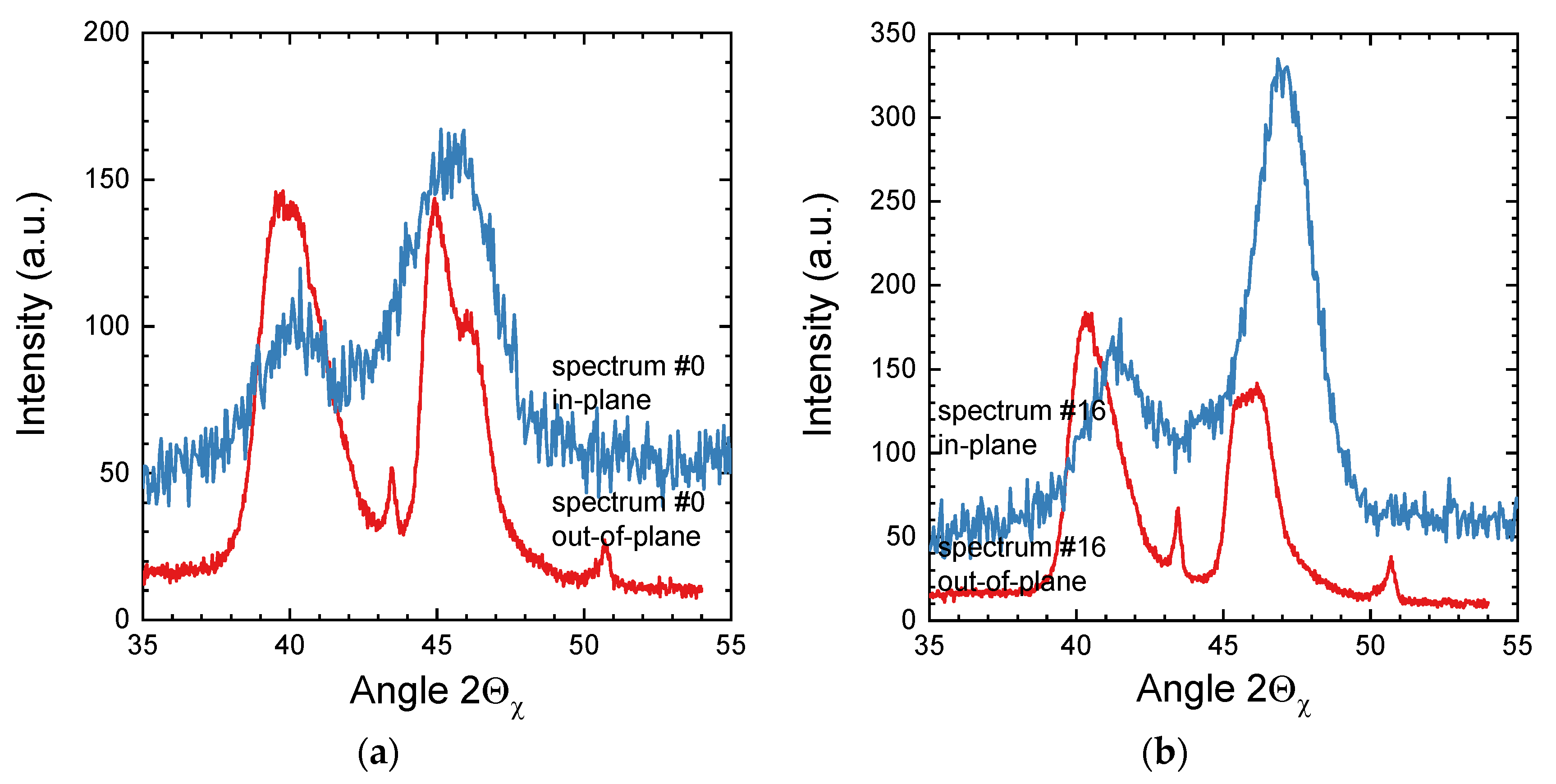

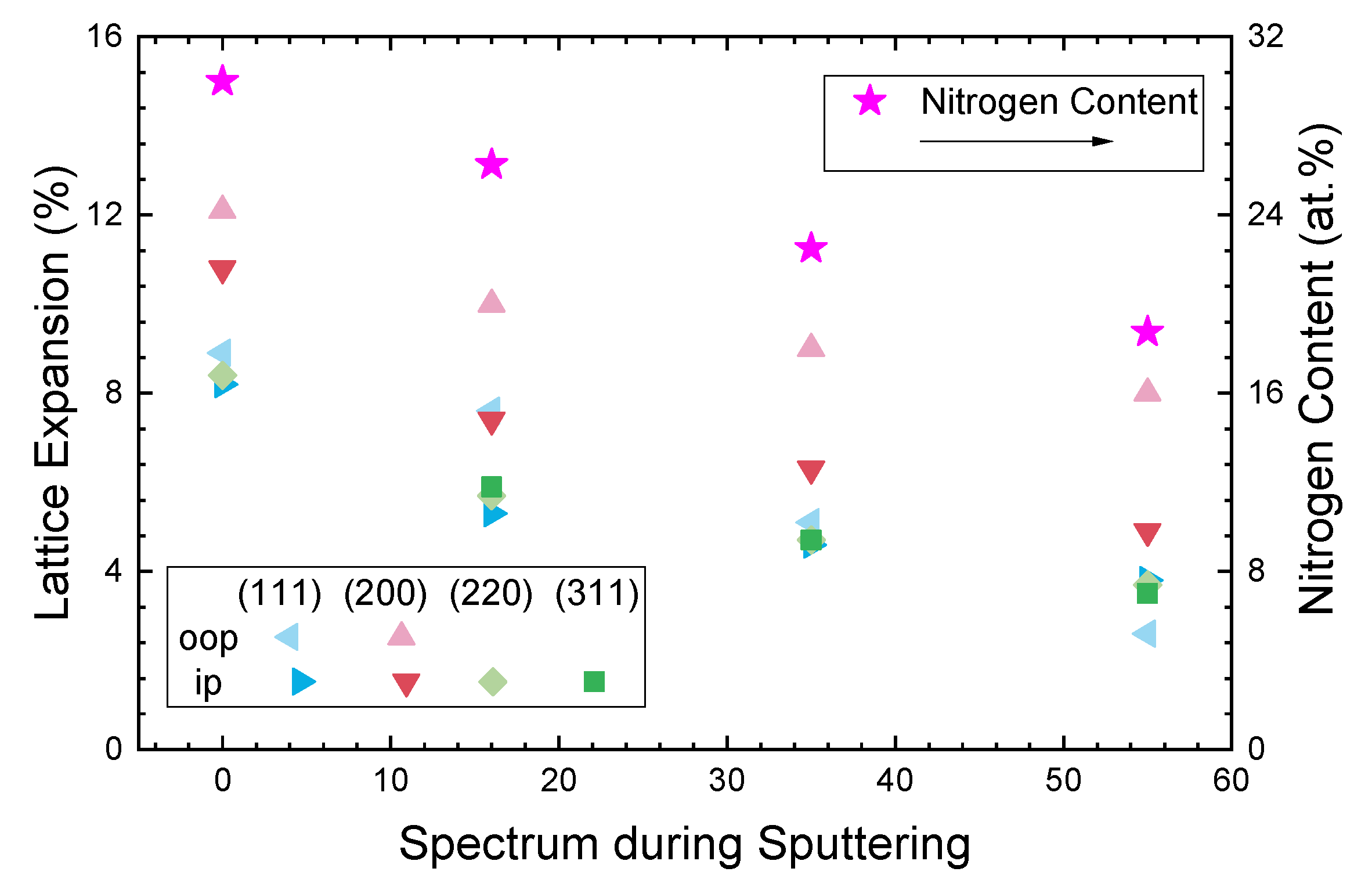
| Spectra # | Comment |
|---|---|
| 0 | surface |
| 16 | transition in (200) exp. phase |
| 35 | bulk of exp. phase |
| 55 | end of (111) exp. phase |
Publisher’s Note: MDPI stays neutral with regard to jurisdictional claims in published maps and institutional affiliations. |
© 2020 by the authors. Licensee MDPI, Basel, Switzerland. This article is an open access article distributed under the terms and conditions of the Creative Commons Attribution (CC BY) license (http://creativecommons.org/licenses/by/4.0/).
Share and Cite
Manova, D.; Schlenz, P.; Gerlach, J.W.; Mändl, S. Depth-Resolved Phase Analysis of Expanded Austenite Formed in Austenitic Stainless Steel. Coatings 2020, 10, 1250. https://doi.org/10.3390/coatings10121250
Manova D, Schlenz P, Gerlach JW, Mändl S. Depth-Resolved Phase Analysis of Expanded Austenite Formed in Austenitic Stainless Steel. Coatings. 2020; 10(12):1250. https://doi.org/10.3390/coatings10121250
Chicago/Turabian StyleManova, Darina, Patrick Schlenz, Jürgen W. Gerlach, and Stephan Mändl. 2020. "Depth-Resolved Phase Analysis of Expanded Austenite Formed in Austenitic Stainless Steel" Coatings 10, no. 12: 1250. https://doi.org/10.3390/coatings10121250
APA StyleManova, D., Schlenz, P., Gerlach, J. W., & Mändl, S. (2020). Depth-Resolved Phase Analysis of Expanded Austenite Formed in Austenitic Stainless Steel. Coatings, 10(12), 1250. https://doi.org/10.3390/coatings10121250




